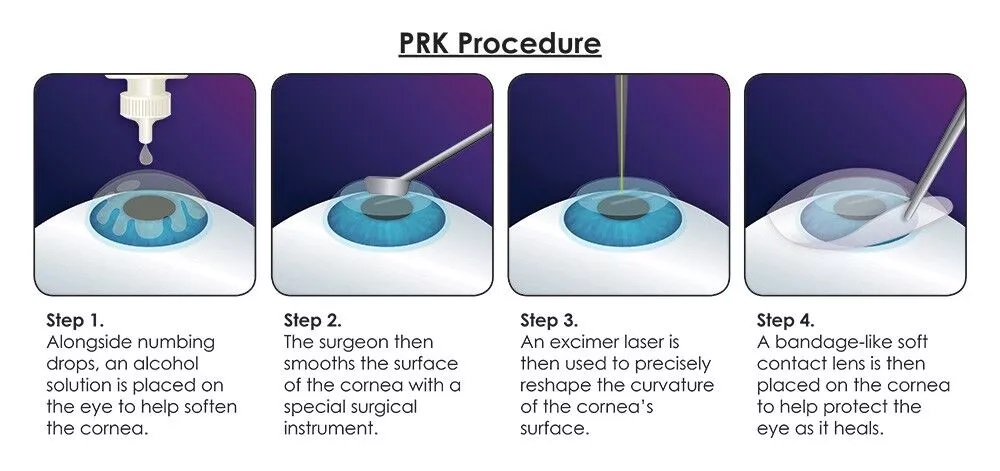Photorefractive Keratectomy is the first vision correction technique using an excimer laser. The first vision correction using PRK was carried out in Berlin in 1985. The technology of Photorefractive Keratectomy was a non-contact excimer laser effect on the surface layers of the cornea without affecting the internal structures of the eye.
Also, as in radial keratotomy, the cornea of the eye was exposed. But the application of notches was no longer required. The shape of the cornea changed under the influence of a laser, which evaporated the tissue from the surface. High accuracy made it possible to achieve good predictability of the result, a significant reduction in side effects. But for the patient, the period of recovery of the surface layer (2-4 days) remained unpleasant, while adaptation ended only after 3-4 weeks. Laser vision correction according to the PRK method was not performed immediately on both eyes.
To eliminate these points, the PRK correction was modified. Now, after laser exposure, a special protective lens is used, which made it possible to reduce the recovery period, it became possible to carry out correction on both eyes at once. Now this technique is used in ophthalmological clinics exclusively for medical reasons to achieve the best results in cases where correction by other methods is impossible.
Limits of Application of Laser Vision Correction according to the PRK method:
Myopia from -1.0 to -6.0 D.
Astigmatism from -0.5 to -3.0 D.
Hyperopia up to +3.0 D.
Stages of Laser Vision Correction using the PRK method:
• Anesthetic drops are instilled into the patient’s eye (anesthesia or anesthetic injections are not used).
• After the anesthesia has worked, an eyelid speculum is used. It keeps the eyelids from blinking.
• The patient is asked to look at a luminous dot in the device to center the position of the eye. If necessary, the eye is fixed with a vacuum ring.
• The epithelium is removed from the area that will be affected by laser radiation.
• With the help of an excimer laser, a new surface of the cornea is formed. The course of laser correction is controlled by an ophthalmic surgeon.
• After the laser correction is completed, the cornea is washed with a special solution. The patient is given anti-inflammatory drops. The patient during the recovery period needs to wear a special protective lens.
Laser correction according to the PRK method is performed in the “one day” mode. During PRK vision correction, the laser changes the outer layers of the cornea, so there is no deep surgical intervention during the correction.
The laser operates in a scanning mode, “smoothes” and “models” the surface of the cornea, ensuring the accuracy and predictability of the result.
Since, as a result, the surface layer of the cornea – the epithelium and Bowman’s membrane – is damaged, special protective contact lenses are used to eliminate discomfort.

Benefits of choosing AstraMedicaGroup
Only top qualified doctors
JCI certificated hospitals
Free COVID-19 Test before departure
4 nights in a 5-star hotel in Istanbul
Costs for laboratory, medication and equipment
Pre/post-operative tests
Free Istanbul tours
Latest technologies
Excelent travel assistance
All-round VIP transfer
Credit / Debit cards accepted
No prepayment
Personal assistants speak in English
24/7 customer service

